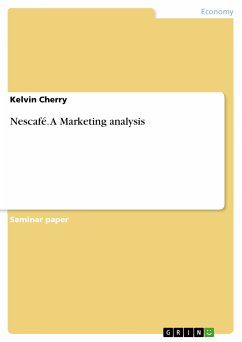Seminar paper from the year 2011 in the subject Business economics - Offline Marketing and Online Marketing, grade: A, The University of Liverpool, language: English, abstract: Nescafe, being a product of a famous brand nestle have been successful in capturing a high market share of instant coffee. The word Nescafe is actually the portmanteau of two words that are “Nestle” and “café”. Max Mergenthaler along with his team members had worked hard for almost seven years to make coffee powder. On April 1, 1930 for the first time in Switzerland, they succeeded. It was launched in the United States with a brand name known as Taster’s Choice Nescafe. However, the brand name was once again changed and was then known as Nescafe Taster Choice. Marketing structure Marketing strategy Nestle is one of those products that is considered to be people and brand oriented rather than being system oriented. Their marketing strategy is designed in a way that gives importance to the needs and lifestyles of their consumers. The product is of high quality they also try to improve their pricing strategy and distribution networks. Along with all these priorities they are able to generate annual profits (Wentzand Newbery, 2010).

